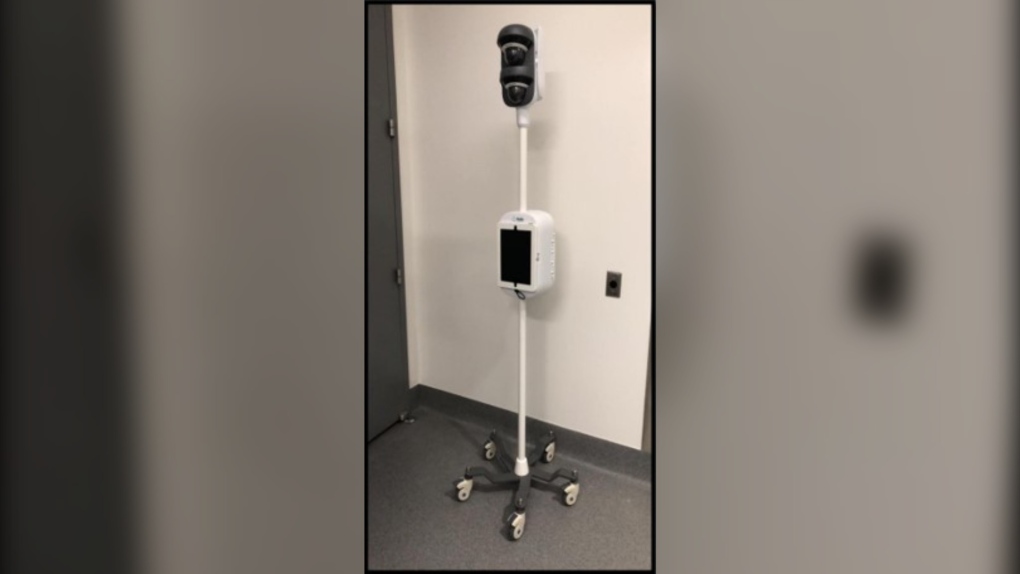'Our way forward': HSC using new technology to monitor patients
 The Halo tele-monitoring equipment. (Source: Shared Health)
The Halo tele-monitoring equipment. (Source: Shared Health)
The Health Sciences Centre (HSC) Winnipeg is trying out a new way to safely watch more patients around the clock, but with fewer staff.
Using bedside cameras, the province’s largest hospital is expected to reduce falls and other adverse events -- things that may only take a second to happen but could affect a person's recovery.
Dr. Shawn Young, HSC Winnipeg’s chief operating officer, told CTV News Winnipeg the hospital has to get creative.
“It is our way forward through this,” Young said.
“We have a tremendous backlog of patients that we have got to be able to serve and we just can't do it with the staff we currently have. We are going to be short for many years. This staff shortage isn’t something that is going to be solved immediately, it’s going to be very slow incremental work.”
The pilot project is called the HALO Monitoring Program and it is similar to a two-way video baby monitor, with the units having a camera and audio unit mounted on what looks like an IV pole.
The program is a partnership with Toronto’s University Health Network (UHN), who will be remotely monitoring the live streams.
HSC Winnipeg will have seven HALO units. They are being used, with patient and family permission, in one surgical ward and one medical ward for nine months. Patients are chosen based on medical appropriateness.
The pilot project started at the end of January.
HSC Winnipeg is the first hospital in Manitoba to use this tele-monitoring technology, but the program has been successfully adopted in hospitals across Canada, including all inpatient units at UHN facilities in Toronto.
CTVNews.ca Top Stories

'We'll never be the 51st state,' Premier Ford says following Trump’s latest jab
Ontario Premier Doug Ford says Canada will "never be the 51st state," rebuking U.S. President-elect Donald Trump’s latest social media post.
'Why would I box myself in?': Singh on why he won't commit to helping bring Trudeau's gov't down, yet
NDP Leader Jagmeet Singh says U.S. president-elect Donald Trump's looming tariff threat is part of the reason why he's not committing to voting non-confidence in Prime Minister Justin Trudeau's government.
B.C. man drops camera into ocean, accidentally captures 'breathtaking' whale video
Before it turned into an extraordinary day, Peter Mieras says it began being quite ordinary.
Elon Musk comes out swinging against government spending package in early test of his political might
Elon Musk derided a Republican-backed government spending bill that if not passed by Friday night would lead to a government shut down.
Providing MAID to man on day pass from B.C. psychiatric ward was 'unlawful,' family alleges
A 52-year-old man who was provided with a medically assisted death while out on a day pass from a B.C. psychiatric hospital should never have been approved for the life-ending procedure, his family alleges in a recently filed wrongful death lawsuit.
Donald Trump says Canada becoming 51st U.S. state is 'a great idea.' Jean Charest calls the comment a 'wake-up call'
U.S. President-elect Donald Trump is taking aim at Canada once more, saying it would be 'a great idea' to make it America's ‘51st state.'
Police suspect Utah father killed his wife and 3 kids, wounded son, then killed himself
Five people were found dead in a Utah home after a man apparently shot his wife and four children before killing himself, police said Wednesday. A 17-year-old boy survived but has a severe brain injury.
Invasive 'murder hornets' are wiped out in the U.S., officials say
The world's largest hornet, an invasive breed dubbed the “murder hornet” for its dangerous sting and ability to slaughter a honey bee hive in a matter of hours, has been declared eradicated in the U.S., five years after being spotted for the first time in Washington state near the Canadian border.
'An enormous problem': Court delays plague criminal cases across the country
Legal delays are making it increasingly difficult for people to have their day in court. One Saskatoon family says they missed out on justice after delays forced the judge to stay proceedings in an impaired driving case that killed their daughter.

































